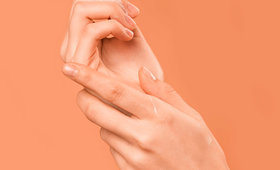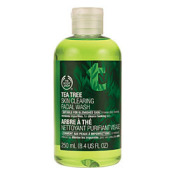It smells soothing and minty fresh, and gives your scalp a refreshing zing when used in hair products (hello, Paul Mitchell’s cult-favorite shampoo). But tea tree oil has some amazing properties beyond the tingling sensation it gives, as well as a wide range of historical uses from treating infections to fighting acne.

Tea tree oil has been widely used for about a century, and was said to have been carried by soldiers in World War II to treat infections in cuts and wounds. More recently, studies have shown that topically, tea tree oil may be effective in reducing MRSA infections. Still, there are plenty of myths and misconceptions about this natural remedy. To get more information about this naturally occurring oil and what it can do for us, we consulted Cecilia Wong, a renowned facialist and founder of Cecilia Wong Skincare, which includes an essential oil–based product line and a New York City spa.
What is tea tree oil?
This essential oil is extracted from the Melaleuca alternifolia plant species, commonly known as the Narrow-leaved Paperbark, Narrow-leaved Tea Tree, or Snow-in-Summer. The shrub-like tree is native to Australia and became popular in the 1920s when reports of its antiseptic properties were first published. As far as skin goes, Wong says, tea tree is most commonly used as an ingredient in skin and hair products to combat acne, fungus, bacteria, blackheads, whiteheads, and oily or combination skin.
Which problems can tea tree oil help address?
These days, tea tree oil is probably most recognized for its ability to balance oily skin and treat whiteheads and blackheads caused by excess oil and dirt. It helps with breakouts because it dries out the top layer of skin—so that means it can be very drying. The key to experimenting with it: ask a dermatologist first and always dilute it with water (see recommended dilution below). Tea tree typically won’t work on cystic acne, which is usually caused by a hormonal issue, not oil, says Wong.
What’s the proper way to use or apply tea tree oil?
Before adding it to your beauty routine, Wong suggests consulting with a professional. “It can cause flakiness and dry patches, so I recommend it only for those who have oily or overactive skin,” she says. If you have sensitive, delicate, and dry skin, skip it.
If you’re ready to give it a test run, dilute your tea tree oil in water using a 1-1 ratio: one drop of the oil to one drop of water. Then, test a small amount on clean skin (try the inside of your forearm) 24 hours prior to using. If you don’t notice any irritation or reaction, go ahead and try it out: swipe your diluted formula on as you would a toner after cleansing, and follow up with moisturizer. Start with a few treatments a week. If skin isn’t responding, work up to once a day.
Rather skip the diluting and DIY’ing? Go for a highly recommended cleanser or toner that contains a pre-diluted amount of tea tree oil. For controlling acne and too-oily skin, many swear by The Body Shop Tea Tree Clearing Facial Wash and LUSH Tea Tree Water Toner.

Are there any risks associated with using it?
“The most common complaints are that it dries out skin, leaving it more sensitive, red, or flaky,” says Wong. One important thing to remember, though, is tea tree oil can only be used topically—it’s toxic when ingested.
**If I find tea tree oil too pungent, what’s a good swap? **
Another caveat: the scent, which some find too overpowering. Wong suggests trying eucalyptus oil as a good substitute. “It has the same benefits and properties, but it doesn’t dry the skin as much and the scent isn’t nearly as overpowering,” she says. For an easy DIY spray toner, mix four to five drops of eucalyptus oil with water in a spray bottle. Spritz the face throughout the day to refresh and rejuvenate skin.
Why is tea tree so great for hair, if it can dry out the face?
Your scalp is very different from your skin—and tea tree oil is great in shampoo and conditioner, as it absorbs grease. And in pre-mixed products, the ingredient will be diluted into a low concentration that shouldn’t irritate the scalp. “However it’s important to moisturize afterwards, just like you’d do after cleansing the skin,” explains Wong, “to help restore the scalp to its pH balance.”
Photo: Serg Myshkovsky
Featured Products
You Might Also Like
-

Moisturizer
Top 3 Daytime Moisturizers For Winter
- 153
-

Skincare
Beauty Secrets From "Afrobella"
- 53
-

Self-Tanners
The Best Smelling Self-Tanners
- 98
-

Hand Treatments
7 Hydrating Creams for Extremely Dry Hands
- 55
-

Skincare
Everything You Need to Know About Moisturizers
- 1055
-

Sun Protection
Natural Looking Sunscreen
- 29
-

Skincare
The Right Order to Apply Your Skin Care
- 784
-

From the Shop
What Is Quercetin?
- 288














